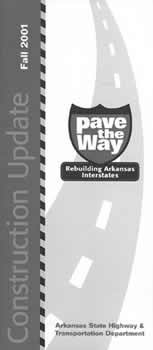U.S. Department of Transportation
Federal Highway Administration
1200 New Jersey Avenue, SE
Washington, DC 20590
202-366-4000
Focus
| Accelerating Infrastructure Innovations |
Publication Number: FHWA-RD-02-004
Date: November 2001
Under an ambitious $1 billion Interstate rehabilitation program, the Arkansas State Highway and Transportation Department (AHTD) will rubblize 444 km (276 mi) of concrete roads and overlay them with a Superpave mix by 2005. As part of the program, which began in 2000, 102 km (64 mi) of existing asphalt pavement will also be overlaid and 64 km (40 miles) of portland cement concrete (PCC) will be completely reconstructed.
Prior to the start of the project, 60 percent, or 611 km (380 mi), of Arkansas's Interstate System had been rated in fair to poor condition and in serious need of rehabilitation.
 |
 Participants in the Arkansas Interstate Rubblization and Rehabilitation Showcase were given a field visit to two construction sites on I-40 |
 To give State and Federal highway officials, contractors, industry personnel, and others a first-hand look at the project, AHTD, the Arkansas Asphalt Pavement Association, and the Federal Highway Administration (FHWA) hosted an Arkansas Interstate Rubblization and Rehabilitation Showcase in June 2001. Approximately 240 participants from 17 States attended a seminar on the program at Arkansas Tech University and then were given a field visit to two construction sites on I-40 near Russellville, Arkansas. "The feedback from the showcase was very positive. We had a lot of participants requesting information on the project," says Lester Frank of FHWA.
To give State and Federal highway officials, contractors, industry personnel, and others a first-hand look at the project, AHTD, the Arkansas Asphalt Pavement Association, and the Federal Highway Administration (FHWA) hosted an Arkansas Interstate Rubblization and Rehabilitation Showcase in June 2001. Approximately 240 participants from 17 States attended a seminar on the program at Arkansas Tech University and then were given a field visit to two construction sites on I-40 near Russellville, Arkansas. "The feedback from the showcase was very positive. We had a lot of participants requesting information on the project," says Lester Frank of FHWA.
Rubblization and overlay is a concrete pavement rehabilitation technique that prevents reflection cracking and provides a solid base for the new pavement. A breaker machine is applied to the concrete pavement, with the pavement being broken into small pieces at the top and larger pieces at the bottom. The rubblized pavement is compacted using vibratory rollers. Hot-mix asphalt (HMA) is then laid over this base. Breaking the concrete helps to ensure that joints, cracks, and other defects will not reflect through the overlay and affect performance. The process also saves time and resources, as the rubblized roadbed does not have to be trucked away as waste. The new pavement is being designed with a 20-year design life based on the 1993 American Association of State Highway and Transportation Officials Pavement Design Guide.
 |
An important consideration when rubblizing pavements is pavement drainage. AHTD installed edge drains before the rubblization work to drain water brought up through the soil. This drainage is critical to the future performance of the pavement.
According to Phil McConnell, head of the Division of Roadway Design at AHTD, the cost of the rubblization and overlay work is $2.2 million per mile. The average work time is about one lane mile per day. The rehabilitation work is being financed by a combination of Grant Anticipation Revenue Vehicle (GARVEE) bonds and a 4-cent-per-gallon tax on diesel. The 12-year GARVEE bonds will be paid off primarily from future Federal Aid for Interstate maintenance.
To ease traffic congestion in urban areas, much of the rehabilitation work is being done at night. An innovative safety technique known as the "Merge Left" policy has also contributed to keeping a steady flow of traffic through the work zones. All of the work zones begin by having traffic merge to the left lane. Signs then direct motorists through the work zone. "People now know what to expect and are merging earlier, helping to maximize travel through the work zones," says Farrell Wilson of AHTD. Equally innovative has been a public awareness campaign, known as "Pave the Way," that has kept motorists up to date on the program.
For more information on the Arkansas rubblization project, contact Ralph Hall, Assistant Chief Engineer of Operations at AHTD, 501-569-2221 (email: ralph.hall@ahtd.state.ar.us).
Since the Arkansas Interstate rehabilitation program began in 2000, motorists have been reminded to "Think Ahead" as they navigate the many miles of work zones. A public information campaign dubbed "Pave the Way" is making this navigation easier by publicizing the rehabilitation work and providing resources to motorists to help them plan ahead for the construction. The campaign includes such features as public service announcements, printed brochures and posters, a monthly newsletter with construction updates and progress reports, highway advisory radio broadcasts, and variable message signs near work zones that display real-time information. A comprehensive Web site (www.ArkansasInterstates.com) also provides up-to-date information for motorists. "We try to provide as much information in as many ways as possible," says Farrell Wilson of AHTD. "We find that people now understand the program better and have a more positive attitude about the construction." For more information on "Pave the Way," contact Wilson at 501-569-2326 (email: farrell.wilson@ahtd.state.ar.us).